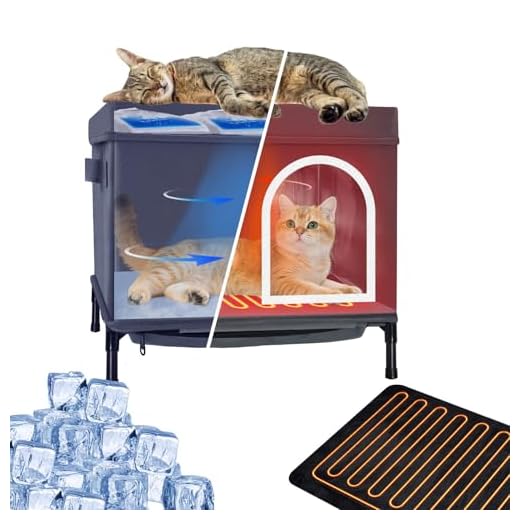

Feeling a bit toasty around my fluffy appendages? It’s often just a sign of excitement or a cozy environment. My body temperature can rise due to playfulness or snuggling in a sunbeam, leading to that warm sensation. Keeping an eye on how my human reacts to my warmth can help determine if everything is okay.
Sometimes, a sudden spike in temperature might indicate stress or illness. If my warmth is accompanied by other unusual behaviors, such as lethargy or lack of appetite, a visit to the vet might be necessary. Regular check-ups are crucial for monitoring my health, ensuring that my cozy demeanor remains just that–cozy.
Creating a comfortable space for me can help manage my temperature. Soft bedding, cool areas to rest, and plenty of hydration are key. Observing my habits and providing a calm environment not only keeps me feeling good but also helps you understand my needs better. Pay attention to those warm moments; they can tell you a lot about how I’m feeling!
Understanding the Anatomy of Cat Ears
The structure of my auditory appendages plays a significant role in how I perceive the world. These unique features are composed of three main parts: the outer ear, the middle ear, and the inner ear. Each segment has specific functions that aid my hearing abilities.
Outer Structure

The outer section, known as the pinna, is shaped like a funnel. This design helps in capturing sound waves efficiently. The flexibility of the pinna allows me to rotate it to pinpoint sounds from various directions. The fur covering my ears helps with insulation and protects sensitive components.
Inner Mechanics
Within the middle ear, there are tiny bones called ossicles that amplify sound vibrations. These vibrations travel to the inner ear, where specialized hair cells convert them into electrical signals sent to my brain. This intricate system enables me to hear high-frequency sounds, which is crucial for hunting and communication.
Common Reasons for Elevated Ear Temperature in Felines
Increased warmth in my auditory regions can arise from various factors. One primary reason is the body’s natural thermoregulation during periods of excitement or stress. When I engage in playful antics or feel anxious, my body temperature may rise, leading to warmer tips.
Infection or Inflammation
Another cause could be infections or inflammation. Conditions like otitis can cause discomfort and elevate temperature in the affected areas. It’s essential for caretakers to monitor for signs of distress, such as excessive scratching or shaking of the head.
Environmental Factors
Exposure to high ambient temperatures also plays a role. Whether lounging in a sunny spot or during hot weather, my body may react by increasing heat in sensitive areas. Hydration and cool resting places are crucial for maintaining comfort.
Always pay attention to any changes in behavior or accompanying symptoms, as these can indicate a need for veterinary consultation. Understanding these factors helps ensure well-being and comfort.
When to Be Concerned About Your Cat’s Hot Ears

If my temperature rises noticeably, it’s time to pay attention. A sudden increase, especially paired with other symptoms, could indicate an underlying issue. Monitor for signs like lethargy, loss of appetite, or unusual behavior.
Signs of Potential Health Issues
Elevated warmth, accompanied by excessive grooming or scratching, might suggest irritation or infection. Watch for swelling or redness; these can be indicators of more serious conditions. If my body temperature exceeds 103°F, consulting a veterinarian is advisable.
Environmental Factors
Extreme heat or prolonged exposure to sunlight can elevate warmth. If I seem distressed or panting excessively, it’s crucial to move to a cooler location. Hydration matters too; ensure fresh water is available. If symptoms persist despite cooling efforts, a vet visit is recommended.
Ways to Help Regulate Your Cat’s Ear Temperature
Maintaining optimal ear comfort is essential for overall well-being. Here are some strategies to help manage temperature:
- Provide a cool resting spot: Ensure a shaded and ventilated area for relaxation. Cats enjoy cool surfaces, especially during warm weather.
- Monitor hydration: Always have fresh water available. Staying hydrated helps regulate body temperature.
- Groom regularly: Regular brushing removes excess fur and helps maintain a comfortable temperature. It also reduces the risk of skin irritations.
- Check for parasites: Regularly inspect for fleas or ticks, as infestations can lead to heat stress. Consider using the best combined flea and worm treatment for cats to prevent these issues.
- Limit exposure to heat: Avoid direct sunlight for prolonged periods. If you notice discomfort, move to a cooler space.
- Assess diet: A balanced diet is crucial. Learn more about hydration with the do cats need wet food daily guide.
- Keep stress levels low: Create a calm environment, as stress can impact overall health.
By following these tips, you can help ensure a comfortable and healthy living environment.
Video:
Feeling a bit toasty around my fluffy appendages? It’s often just a sign of excitement or a cozy environment. My body temperature can rise due to playfulness or snuggling in a sunbeam, leading to that warm sensation. Keeping an eye on how my human reacts to my warmth can help determine if everything is okay.
Sometimes, a sudden spike in temperature might indicate stress or illness. If my warmth is accompanied by other unusual behaviors, such as lethargy or lack of appetite, a visit to the vet might be necessary. Regular check-ups are crucial for monitoring my health, ensuring that my cozy demeanor remains just that–cozy.
Creating a comfortable space for me can help manage my temperature. Soft bedding, cool areas to rest, and plenty of hydration are key. Observing my habits and providing a calm environment not only keeps me feeling good but also helps you understand my needs better. Pay attention to those warm moments; they can tell you a lot about how I’m feeling!
Understanding the Anatomy of Cat Ears
The structure of my auditory appendages plays a significant role in how I perceive the world. These unique features are composed of three main parts: the outer ear, the middle ear, and the inner ear. Each segment has specific functions that aid my hearing abilities.
Outer Structure

The outer section, known as the pinna, is shaped like a funnel. This design helps in capturing sound waves efficiently. The flexibility of the pinna allows me to rotate it to pinpoint sounds from various directions. The fur covering my ears helps with insulation and protects sensitive components.
Inner Mechanics
Within the middle ear, there are tiny bones called ossicles that amplify sound vibrations. These vibrations travel to the inner ear, where specialized hair cells convert them into electrical signals sent to my brain. This intricate system enables me to hear high-frequency sounds, which is crucial for hunting and communication.
Common Reasons for Elevated Ear Temperature in Felines
Increased warmth in my auditory regions can arise from various factors. One primary reason is the body’s natural thermoregulation during periods of excitement or stress. When I engage in playful antics or feel anxious, my body temperature may rise, leading to warmer tips.
Infection or Inflammation
Another cause could be infections or inflammation. Conditions like otitis can cause discomfort and elevate temperature in the affected areas. It’s essential for caretakers to monitor for signs of distress, such as excessive scratching or shaking of the head.
Environmental Factors
Exposure to high ambient temperatures also plays a role. Whether lounging in a sunny spot or during hot weather, my body may react by increasing heat in sensitive areas. Hydration and cool resting places are crucial for maintaining comfort.
Always pay attention to any changes in behavior or accompanying symptoms, as these can indicate a need for veterinary consultation. Understanding these factors helps ensure well-being and comfort.
When to Be Concerned About Your Cat’s Hot Ears

If my temperature rises noticeably, it’s time to pay attention. A sudden increase, especially paired with other symptoms, could indicate an underlying issue. Monitor for signs like lethargy, loss of appetite, or unusual behavior.
Signs of Potential Health Issues
Elevated warmth, accompanied by excessive grooming or scratching, might suggest irritation or infection. Watch for swelling or redness; these can be indicators of more serious conditions. If my body temperature exceeds 103°F, consulting a veterinarian is advisable.
Environmental Factors
Extreme heat or prolonged exposure to sunlight can elevate warmth. If I seem distressed or panting excessively, it’s crucial to move to a cooler location. Hydration matters too; ensure fresh water is available. If symptoms persist despite cooling efforts, a vet visit is recommended.
Ways to Help Regulate Your Cat’s Ear Temperature
Maintaining optimal ear comfort is essential for overall well-being. Here are some strategies to help manage temperature:
- Provide a cool resting spot: Ensure a shaded and ventilated area for relaxation. Cats enjoy cool surfaces, especially during warm weather.
- Monitor hydration: Always have fresh water available. Staying hydrated helps regulate body temperature.
- Groom regularly: Regular brushing removes excess fur and helps maintain a comfortable temperature. It also reduces the risk of skin irritations.
- Check for parasites: Regularly inspect for fleas or ticks, as infestations can lead to heat stress. Consider using the best combined flea and worm treatment for cats to prevent these issues.
- Limit exposure to heat: Avoid direct sunlight for prolonged periods. If you notice discomfort, move to a cooler space.
- Assess diet: A balanced diet is crucial. Learn more about hydration with the do cats need wet food daily guide.
- Keep stress levels low: Create a calm environment, as stress can impact overall health.
By following these tips, you can help ensure a comfortable and healthy living environment.
Video:
Feeling a bit toasty around my fluffy appendages? It’s often just a sign of excitement or a cozy environment. My body temperature can rise due to playfulness or snuggling in a sunbeam, leading to that warm sensation. Keeping an eye on how my human reacts to my warmth can help determine if everything is okay.
Sometimes, a sudden spike in temperature might indicate stress or illness. If my warmth is accompanied by other unusual behaviors, such as lethargy or lack of appetite, a visit to the vet might be necessary. Regular check-ups are crucial for monitoring my health, ensuring that my cozy demeanor remains just that–cozy.
Creating a comfortable space for me can help manage my temperature. Soft bedding, cool areas to rest, and plenty of hydration are key. Observing my habits and providing a calm environment not only keeps me feeling good but also helps you understand my needs better. Pay attention to those warm moments; they can tell you a lot about how I’m feeling!
Understanding the Anatomy of Cat Ears
The structure of my auditory appendages plays a significant role in how I perceive the world. These unique features are composed of three main parts: the outer ear, the middle ear, and the inner ear. Each segment has specific functions that aid my hearing abilities.
Outer Structure

The outer section, known as the pinna, is shaped like a funnel. This design helps in capturing sound waves efficiently. The flexibility of the pinna allows me to rotate it to pinpoint sounds from various directions. The fur covering my ears helps with insulation and protects sensitive components.
Inner Mechanics
Within the middle ear, there are tiny bones called ossicles that amplify sound vibrations. These vibrations travel to the inner ear, where specialized hair cells convert them into electrical signals sent to my brain. This intricate system enables me to hear high-frequency sounds, which is crucial for hunting and communication.
Common Reasons for Elevated Ear Temperature in Felines
Increased warmth in my auditory regions can arise from various factors. One primary reason is the body’s natural thermoregulation during periods of excitement or stress. When I engage in playful antics or feel anxious, my body temperature may rise, leading to warmer tips.
Infection or Inflammation
Another cause could be infections or inflammation. Conditions like otitis can cause discomfort and elevate temperature in the affected areas. It’s essential for caretakers to monitor for signs of distress, such as excessive scratching or shaking of the head.
Environmental Factors
Exposure to high ambient temperatures also plays a role. Whether lounging in a sunny spot or during hot weather, my body may react by increasing heat in sensitive areas. Hydration and cool resting places are crucial for maintaining comfort.
Always pay attention to any changes in behavior or accompanying symptoms, as these can indicate a need for veterinary consultation. Understanding these factors helps ensure well-being and comfort.
When to Be Concerned About Your Cat’s Hot Ears

If my temperature rises noticeably, it’s time to pay attention. A sudden increase, especially paired with other symptoms, could indicate an underlying issue. Monitor for signs like lethargy, loss of appetite, or unusual behavior.
Signs of Potential Health Issues
Elevated warmth, accompanied by excessive grooming or scratching, might suggest irritation or infection. Watch for swelling or redness; these can be indicators of more serious conditions. If my body temperature exceeds 103°F, consulting a veterinarian is advisable.
Environmental Factors
Extreme heat or prolonged exposure to sunlight can elevate warmth. If I seem distressed or panting excessively, it’s crucial to move to a cooler location. Hydration matters too; ensure fresh water is available. If symptoms persist despite cooling efforts, a vet visit is recommended.
Ways to Help Regulate Your Cat’s Ear Temperature
Maintaining optimal ear comfort is essential for overall well-being. Here are some strategies to help manage temperature:
- Provide a cool resting spot: Ensure a shaded and ventilated area for relaxation. Cats enjoy cool surfaces, especially during warm weather.
- Monitor hydration: Always have fresh water available. Staying hydrated helps regulate body temperature.
- Groom regularly: Regular brushing removes excess fur and helps maintain a comfortable temperature. It also reduces the risk of skin irritations.
- Check for parasites: Regularly inspect for fleas or ticks, as infestations can lead to heat stress. Consider using the best combined flea and worm treatment for cats to prevent these issues.
- Limit exposure to heat: Avoid direct sunlight for prolonged periods. If you notice discomfort, move to a cooler space.
- Assess diet: A balanced diet is crucial. Learn more about hydration with the do cats need wet food daily guide.
- Keep stress levels low: Create a calm environment, as stress can impact overall health.
By following these tips, you can help ensure a comfortable and healthy living environment.









